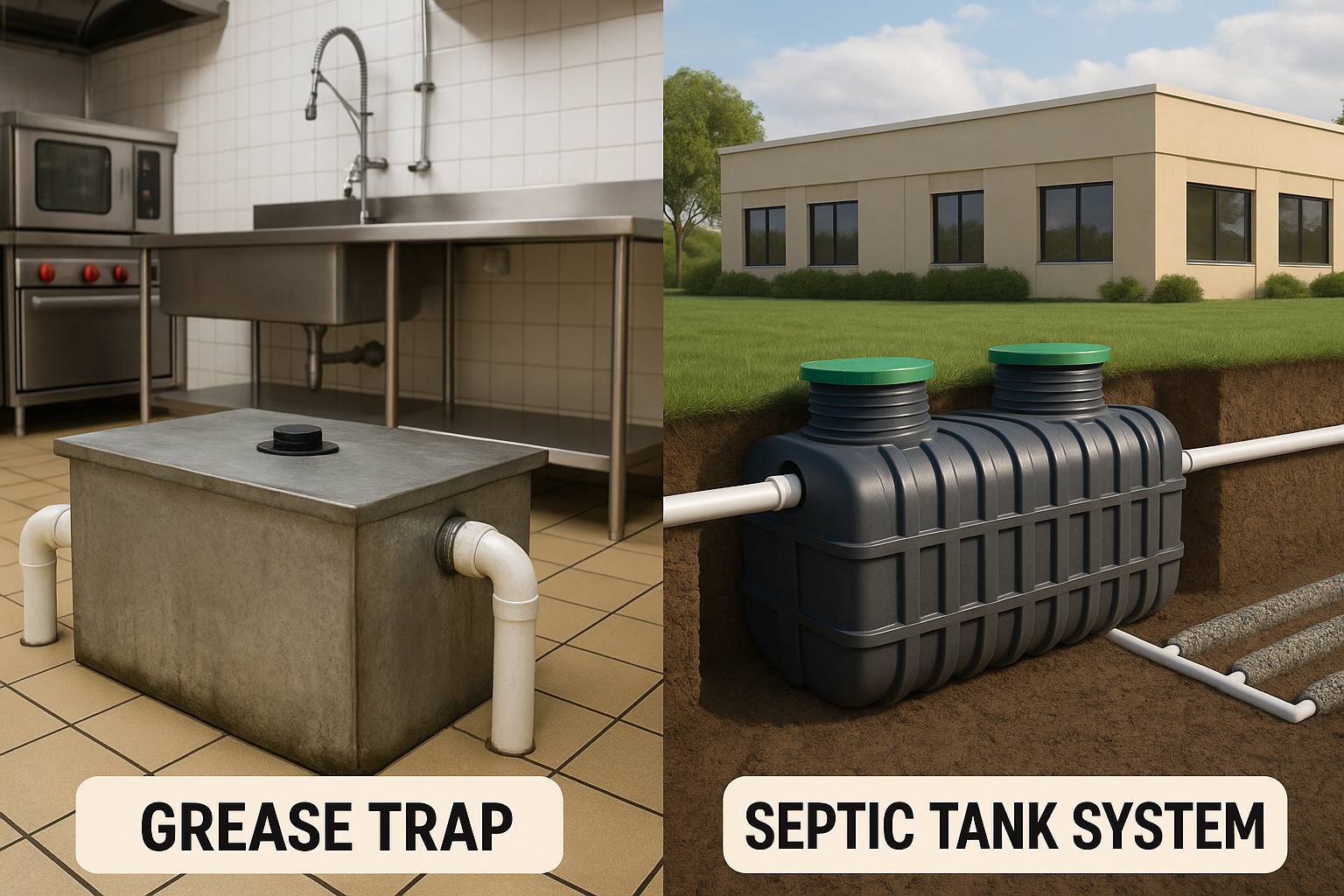Have you ever wondered whether your business really needs a grease trap, or if a septic tank is enough to handle your wastewater needs? This is a common question among restaurants, cafés, and other foodservice businesses, and it often leaves owners feeling confused and overwhelmed. Understanding the difference between grease trap and septic tank is not just academic—it is critical for protecting your operations and avoiding costly mistakes. Grease traps and septic tanks both help manage wastewater, but their functions, maintenance, and compliance requirements differ significantly. For example, neglecting a grease trap can lead to clogged plumbing and violations of local health codes, while improper septic tank care can result in environmental contamination and expensive repairs like high septic tank pumping cost.
Choosing the right system—or combination of systems—ensures your business stays compliant, safe, and efficient. Regular adherence to septic tank maintenance tips and a structured grease trap maintenance schedule can save time and money while preventing unnecessary emergencies. For restaurants, following restaurant grease trap requirements and planning grease trap installation cost carefully is essential. Similarly, properties relying on septic systems should consider septic system inspection checklist routines and septic tank repair services when needed.
In this comprehensive guide, we’ll explore how these systems differ, their respective benefits, and practical strategies for maintenance. You’ll gain actionable insights into industrial grease trap solutions, industrial kitchen waste solutions, and kitchen waste management solutions, helping your business avoid plumbing headaches and regulatory fines. By the end of this article, you’ll have the tools to make informed decisions that protect both your operations and your bottom line, while ensuring sustainable and efficient wastewater management.
Understanding the Basics of Grease Traps and Septic Tanks
Wastewater management has existed for centuries, but modern systems are far more specialized. Septic tanks are widely used in areas without municipal sewer connections and handle all types of wastewater by breaking down solids and dispersing liquids safely into the soil. Grease traps, however, became essential with the rise of the restaurant industry, designed to prevent FOG (fats, oils, grease) from clogging plumbing and municipal sewer lines. Both systems serve critical roles, yet their designs, maintenance requirements, and regulatory expectations differ considerably.
Proper commercial septic tank design, adherence to septic system inspection checklist routines, and following septic tank maintenance tips are necessary to avoid failures. Grease traps require accurate sizing using a grease trap capacity calculator, compliance with grease interceptor regulations, and regular grease trap cleaning services according to the recommended grease trap cleaning frequency. Understanding the septic tank vs cesspool comparison clarifies why septic systems are comprehensive, whereas grease trap vs interceptor differences highlight the targeted purpose of grease traps in kitchens.
Restaurants and foodservice businesses must also comply with restaurant wastewater management standards to avoid fines. Maintenance considerations like septic tank pumping frequency and monitoring septic tank lifespan factors ensure that both systems operate efficiently and sustainably. With the right knowledge, business owners can implement industrial grease trap solutions and industrial kitchen waste solutions to protect both plumbing infrastructure and the environment. These proactive measures not only prevent costly problems but also help businesses remain compliant and operationally smooth.
The Core Differences Between Grease Traps and Septic Tanks
While grease traps and septic tanks both manage wastewater, they address very different challenges. A grease trap intercepts fats, oils, and grease before they enter plumbing systems, while a septic tank treats all wastewater from sinks, toilets, and drains, breaking down solids and dispersing liquid safely into the soil. Understanding these distinctions is vital for compliance and preventing costly repairs. Proper sizing and installation using grease trap capacity calculator tools or commercial septic tank design ensures optimal system performance.
Location in the System – Grease traps are typically installed inside or just outside kitchens, whereas septic tanks are buried underground, servicing the entire property. Proper placement affects both efficiency and maintenance requirements, with restaurants needing to meet restaurant grease trap requirements.
Maintenance Needs – Grease traps must be cleaned consistently, following grease trap maintenance schedule or by hiring grease trap cleaning services. Septic tanks require periodic pumping, considering septic tank pumping frequency to prevent failures. Business owners should also consider septic tank repair services when problems arise, following septic tank pump-out regulations to remain compliant.
Who Needs Them – Foodservice establishments require grease traps, while properties without municipal sewer systems rely on septic tanks. Using both systems together ensures that grease from kitchens doesn’t overwhelm septic systems, protecting the property’s plumbing infrastructure. Adhering to grease trap code compliance and monitoring septic system inspection checklist items ensures long-term functionality. Overall, understanding these core differences helps business owners choose the right systems, maintain them efficiently, and avoid costly environmental and plumbing issues.
Why These Systems Benefit Your Business
Investing in the right wastewater system protects your business, your staff, and your bottom line. Properly installed and maintained systems deliver numerous benefits:
- Protects Your Plumbing – Grease traps and septic tanks prevent clogs, blockages, and emergency plumbing repairs by intercepting grease and solids. Using septic system troubleshooting guide and grease trap code compliance ensures system efficiency.
- Improves Compliance – Following restaurant grease trap requirements and septic system regulations by state avoids fines and closures.
- Supports Continuity – Regular maintenance minimizes unexpected breakdowns, keeping kitchens or facilities running smoothly.
- Saves Money – Planned grease trap installation cost and septic system installation cost reduce the need for expensive overhauls.
- Promotes Sustainability – Implementing eco-friendly septic solutions and grease trap odor control methods protects the environment.
A small restaurant might hire local grease trap installers and combine this with small business septic solutions to maximize operational efficiency. Additionally, implementing industrial kitchen waste solutions and industrial grease trap solutions enhances waste management practices, ensuring compliance and sustainability. Businesses that prioritize these benefits not only protect plumbing but also strengthen staff workflow, customer confidence, and overall reputation, positioning themselves for long-term operational success.
Challenges You’ll Want to Keep in Mind
Even well-designed systems require attention. Understanding potential challenges helps owners make informed decisions:
- Regular Maintenance Required – Following grease trap maintenance schedule and septic tank maintenance tips is crucial to avoid clogs or overflows.
- Odor Issues – Improper servicing can create unpleasant smells affecting staff and customers.
- Initial Investment Costs – Considering grease trap installation cost and septic system installation cost helps budget properly.
- Limited Capacity – Systems must match waste volumes to prevent breakdowns.
- Strict Regulations – Adhering to restaurant plumbing waste systems and restaurant sewage solutions avoids legal penalties.
Strategies to manage these challenges include:
- Set a Regular Maintenance Schedule – Schedule grease trap cleaning services and septic tank inspection near me consistently.
- Educate Staff – Train employees to avoid introducing inappropriate waste into drains.
- Plan for Capacity – Know your system’s limits, factoring septic tank lifespan factors.
- Keep Good Records – Document septic tank sludge removal and cleaning schedules for compliance audits.
By addressing these challenges proactively, business owners maintain efficient, compliant, and safe wastewater systems without unnecessary disruption.
Putting Your Knowledge into Practice
Understanding how grease traps and septic tanks function is just the first step. Effective application ensures smooth operations:
- Assess Needs – Determine if your business requires a grease trap, a septic tank, or both.
- Check Local Regulations – Follow restaurant grease trap requirements and septic system regulations by state to remain compliant.
- Choose Reliable Service Providers – Hire experts for grease trap cleaning services or septic tank repair services.
- Set a Maintenance Schedule – Maintain grease trap maintenance schedule and septic tank maintenance tips.
- Track and Document Service – Use septic system inspection checklist and records to ensure proper compliance.
Best practices include starting small, involving staff, and measuring progress. Utilize maintenance apps, local health guidelines, and trusted service providers to streamline operations. Following these steps helps avoid costly emergencies, maintain compliance, and create a reliable foundation for business growth.
The Future of Wastewater Management for Businesses
Wastewater management is evolving rapidly. Emerging trends like industrial grease trap solutions, industrial kitchen waste solutions, smart monitoring systems, and eco-friendly septic solutions are reshaping operations. Businesses using grease trap efficiency tips and sustainable practices reduce costs, minimize environmental impact, and ensure compliance.
These innovations improve operational efficiency, reduce downtime, and align with corporate responsibility initiatives. Businesses prepared for future regulations will be better positioned for growth and sustainability while safeguarding customer trust and staff efficiency.
Wrapping Up: Making the Right Choice for Your Business
Grease traps and septic tanks serve distinct purposes; knowing the difference between grease trap and septic tank helps ensure compliance.
Regular care using grease trap cleaning frequency and septic tank pumping frequency prevents failures.
The future favors greener solutions, including commercial kitchen wastewater tips and understanding grease trap vs septic system costs.
Review your setup today—whether scheduling grease trap installation near me, septic tank inspection near me, or evaluating septic system installation cost—to maintain smooth, sustainable operations.
Final Thoughts: Keeping Your System and Business Flowing Smoothly
Understanding the roles of grease traps and septic tanks is more than plumbing—it’s essential to running a business efficiently and sustainably. Applying kitchen waste management solutions, restaurant sewage solutions, and analyzing grease trap vs interceptor differences ensures long-term success. Proactive maintenance, staff education, and compliance with regulations protect both your business and the environment. Learn more about DIY septic tank pump-out risks and benefits to further safeguard your system.






